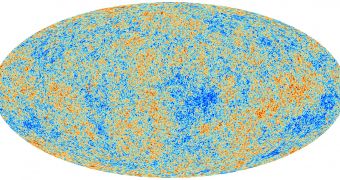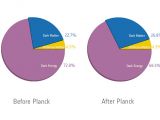The European Space Agency has released the first results of its Plank mission which set out to map the universe as it was in its infancy. After 15 months of observations by the Plank instrument in space, the data is already changing the way we understand the universe.
There aren't any huge revelations, though there are some hints of strange and interesting behavior, but the data has provided a new age of the universe and more accurate numbers for its makeup.
Up until now, the age of the universe was estimated at 13.77 billion years. Analysis of the Plank data indicates that the universe is actually 13.81 billion years old, with a margin of error of plus/minus 50 million years.
Shortly after the Big Bang, all of the matter in the universe was packed together in a very confined space. As a result, none of what we see today existed.
It was only 380,000 years after the Big Bang that the universe grew large enough for atoms to form. Until then, any free photon collided with something shortly after being released, so any light that existed before that date did not survive.
But after the first atoms formed, the universe became a lot roomier. The radius of an atom's nucleus is tens of thousands of times smaller, 145,000 times smaller in the case of hydrogen – which is all that existed at that time, than the radius of the atom itself.
Photons can pass easily through all this empty space and that they did. The first free photons were quite energetic in the ultraviolet spectrum, at about 27,000 degrees Celsius, but cooled down considerably since, and they're now at 2.7 degrees, mostly due to the expansion of the universe.
Those first photons, the first light, are now at the lower end of the microwave spectrum, which is what Plank was designed to look at. This is why it's called the Cosmic Microwave Background Radiation (CMBR). The instrument surveyed the entire sky and put together the most accurate map of the early universe to date.
When the universe became transparent, photons were distributed almost equally across it. There were minute variations in the distribution of matter and energy though; these variations led to the creations of the galaxies and galaxy clusters we see today, but they also left their mark on the photon soup.
What it means is that, in the present, these early photons aren't all equally hot. By measuring their temperature/energy levels very precisely, scientists can map out the density of energy in the early universe. That's the map you see in the first image.
By studying the variations as seen by Plank, scientists now have a more accurate portrait of the distribution of matter, dark matter and dark energy in the universe. It turns out that there is more matter, both regular and dark, in the universe than previously believed, but less dark energy.
The Plank data also settled some disputes; it ruled out the existence of a fourth type of neutrino for example, confirming that there are only three, the three we have discovered, electron, mu and tau.
Finally, the data also provides some proof of inflation, one of the leading theories on the universe's early evolution, though more data is needed to confirm it.

 14 DAY TRIAL //
14 DAY TRIAL // 
